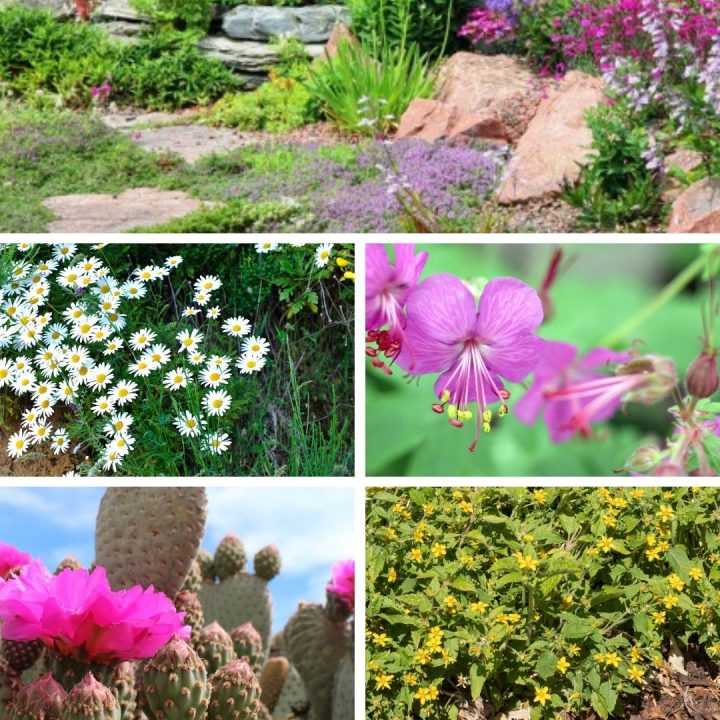Ground Cover Plants to Enhance Your Landscape
Ground cover with flowers is a great way to add some life and beauty to your garden. Not only do these plants help to keep the ground moist and prevent erosion, but they also provide a lovely show of color throughout the different seasons.
In this article, we’ll get into planting ground cover with flowers, as well as the many benefits you may enjoy.
Practical and Attractive
Ground cover plants are attractive, low-growing plants that look great but also have a practical use in the garden. They can help stop weeds from coming through and also cover parts of your landscape where it may be difficult to grow plants.
Different Types of Ground Cover Plants
You can choose different plants for ground cover, including:
- Cactus
- Flowering
- Grasses
- Shrubs
- Vines
Whether you choose perennial flowers that come back year after year or bright annuals that bloom for just a short period of time, there are options to suit every landscape.
With ground cover with flowers, you can transform even the dullest patch of ground into a beautiful floral wonderland! Let’s look deeper into the types of flowering plants you can use as ground cover and how to use them.
Perennial Flowering Ground Cover Plants
Most ground cover plants are also perennials, which means that you plant them once and they will grow on or grow back each season. These landscape plants are favored for getting plants into areas where other plants may not be able to grow well.
Most are are low-growing and tend spread out, and some are fast growing as well, which makes them perfect for covering large areas quickly. Most ground cover plants are also easy to care for, and they can help prevent weeds from taking over your garden.
In fact some of the best, fastest growing ground covers are considered weeds by some, but desirable ground cover plants by others, such as these weeds with purple flowers.
Beyond beauty, flowering ground covers are a great way to add color and interest to your landscaping, upping your curb appeal, and giving you something beautiful to look at. They can also help attract pollinators and are even a good source to fix some common landscaping issues. There are many different types to choose from, so you can find one that will work well in your garden.
Be sure to pick a ground cover that is appropriate for how much sun and shade you have in your garden, as well as the type of soil you have. You should also consider your hardiness zone and average climate.
With a little planning, you can create a beautiful and colorful ground cover for your garden.
Long Blooming Ground Cover Plants That Bloom All Summer
- Mexican daisy – (Erigeron karvinskianus), zone 5-8
- Flower carpet roses – (Rosa x ‘Noaschnee‘), zone 5-8
- Hardy geraniums – (Geranium bohemicum), zone 4-9
- Yellow alyssum – (Alyssum alyssoides), zone 4-9
- Lily of the valley – (Convallaria majalis), zone 3-9
- Rock cress – (Aubrieta deltoidea), zones 5-7
Mexican daisy is a kind of daisy fleabane, an edible and beneficial weed.
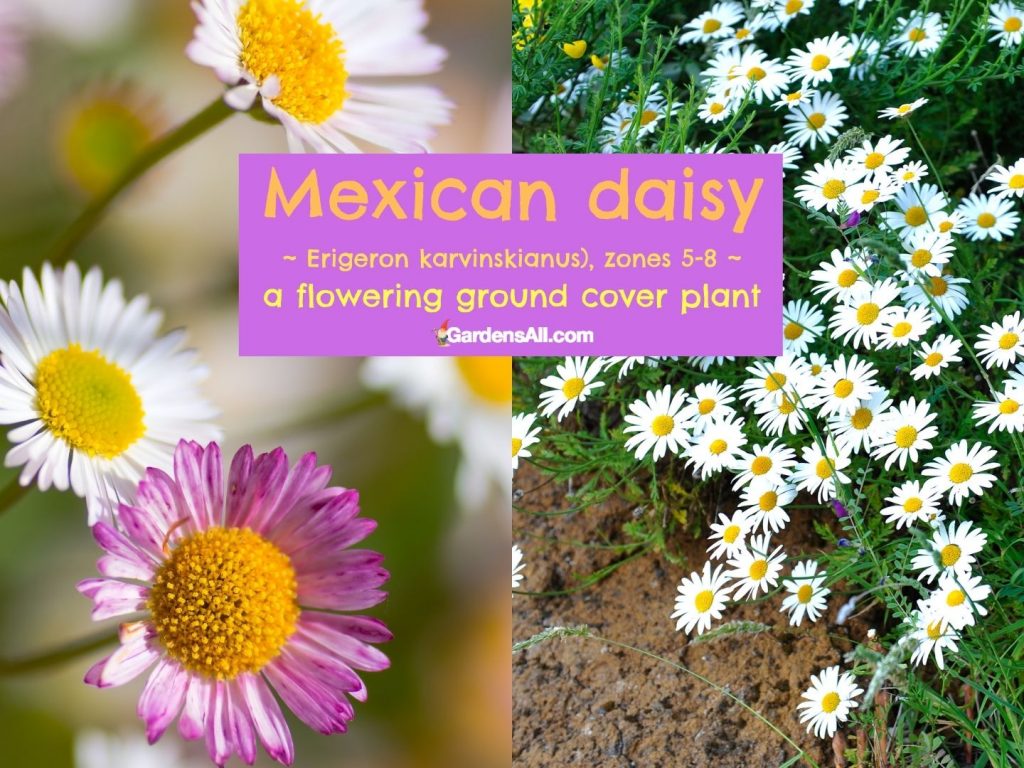
Ground Cover Plants That Bloom Year Round
These ground cover plants bloom all year when in the right hardiness grow zone. They may be able to grow in other zones, but might not flower year round there.
- Wall germander – (Teucrium chamaedrys), zones 5-9
- Prickly pear – (Opuntia basilaris), zones 9-11
- Sedums – (Sedum or Orpine), zones 3-11
- Flowering thyme – (Thymus serpyllum), zones 5-10
- Candytuft – (Iberis sempervirens), zones 3-9
- Creeping phlox – (Phlox stolonifera) zones 3-9

Lists of Ground Cover Plants By Color
Many people choose their landscape plants according to specific color combinations. To help you plan and plant accordingly, the following list of ground cover plants are organized by flower colors.
3 Ground Cover With Blue Flowers
Do you love blue flowers? Are you looking for some ground cover with blue flowers to balance other colors you already have in your garden? Here are some ideas to get you started.
- Speedwell – (Veronica peduncularis), zones 4-9
- Lesser periwinkle – (Vinca minor), zones 4-9
- Creeping rosemary – (Rosmarinus officinalis ‘Prostratus’), zones 4-9
You can use blues to complement orange or red blooms. Blue is such a serene and calming color, and it can really make your garden pop.
Speedwell (Veronica peduncularis)
Also called “Georgia blue”, speedwell is an evergreen, low growing, spreading plant with blue flowers that is great for groundcover.
Lesser Periwinkle (Vinca minor)
Also called creeping Myrtle, here’s another blue groundcover option. This evergreen, mat-forming perennial has dark green glossy leaves and large lavender-blue flowers that bloom from mid-spring to early summer. They will usually continue to flower throughout the summer and into the beginning of fall, depending on your location. They thrive in part shade to full sun, dry to medium soil moisture and well-drained soil.
Creeping Rosemary (Rosmarinus officinalis ‘Prostratus’)
Technically a shrub, creeping rosemary can also be used as ground cover because it is low to the ground. The ‘Prostratus’ variety of Rosmarinus will grow an average of 1.5 feet tall and has an average spread of 2.5 feet wide.
Easily grown in poor soil, rosemary prefers sandy, well-drained soil and full sun, though it will also tolerate light shade. This resilient aromatic flowering ground cover is drought-tolerant once it has time to become established, and is very disease resistant.
We love to foodscape our landscape. Toward that, checkout these edible ground cover plants.

Ground cover with pink flowers
If pink flowers are what you’re after, there are also a lot of great options to consider.
- Bishop’s hat – (Epimedium)
- Flower carpet roses – (Rosa)
- Bigroot geranium – (Geranium macrorrhizum)
Bishop’s hat (epimedium) – This plant has heart-shaped leaves and bold blooms that can be pink, red, or purple. Sometimes they are also orange or bicolored. Pink tends to be the most common, so I’m going to categorize them here.
Flower carpet roses (Rosa) – These roses grow in a group, and they are found in many different colors such as pink, red, white and coral. I’m listing them here under pink but be sure to check the color of the variety you choose. They are hardy and like full sun and are mostly low maintenance.
Bigroot geranium (Geranium macrorrhizum) – This low-maintenance ground cover has beautiful pink, red, or light pink hues. It has variegated foliage that looks great even when the plant is not in bloom. It’s low maintenance and adjusts to many different climates and conditions.
Pink flowers are complementary to shades of greens, and so they’re good companion plants for non-flowering ground covers and other greenery as backdrop.
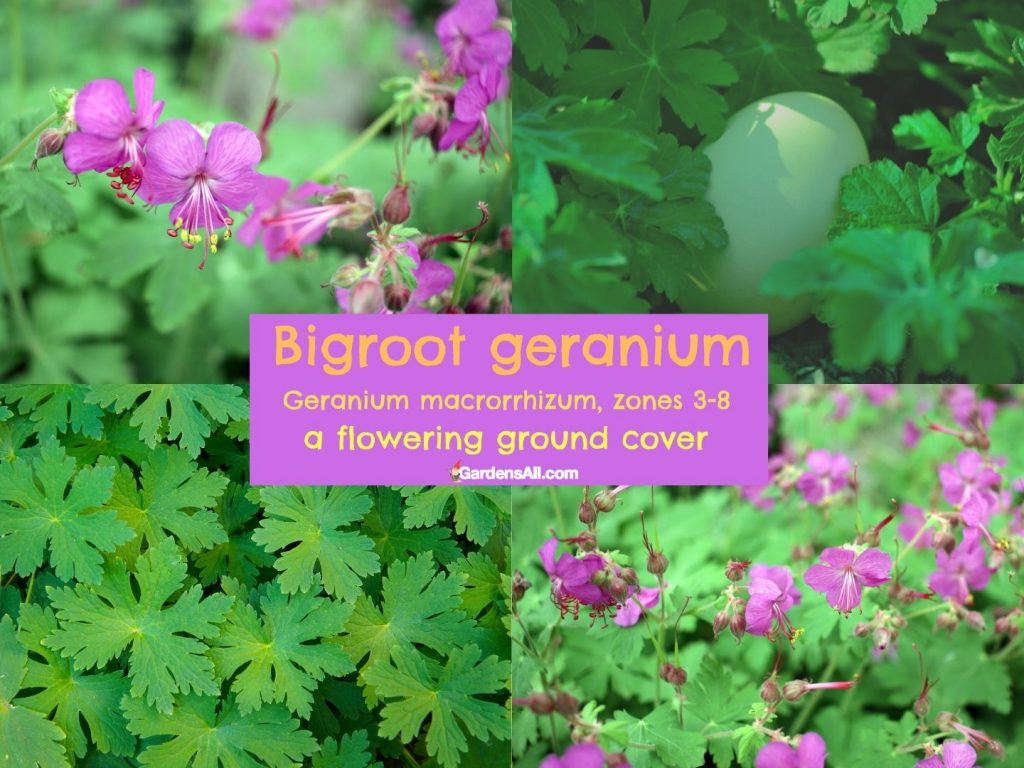
Ground cover with purple flowers
Purple is one of my favorite colors and there is no short supply of ground cover with purple flowers either.
- Bugleweed – (Ajuga-reptans), zones 3-10
- Horned-pansy – (Viola-cornuta)
- Lamb’s ear – (Stachys byzantina)
- Rock cress – (Aubrieta deltoidea), zones 5-7
- Spotted-dead-nettle – (Lamium-maculatum)
Bugleweed – (Ajuga reptans), is a cold-hearty herb with purple flowers that works well as a ground cover. It’s a creeping plant, which means it does a good job of spreading across a surface area of the ground where planted.
Horned pansy – (Viola cornuta), is an annual with round leaves and fragrant flowers that bloom in blue, lavender and purple shades. It will typically bloom from April through June, and it does well in areas with full sun to partial shade. It blooms in early summer to late spring and grows about 8 inches tall.
Rock cress – (Aubrieta deltoidea), is a semi-evergreen perennial that flowers in many colors from spring to summer, and includes vibrant purple hues that range from pale lavender to indigo. Aubrieta is lovely in rock gardens but adaptable to many styles of landscape that are in full sun or mild shade. Rock cress is also drought and deer resistant!
Spotted dead nettle (Lamium maculatum) – This plant is well known for its variegated foliage and the dense clusters of flowers that are shades of purple but can also be white or pink.
What Flowers Goes Well With Purple Flowers?
Some nice complements to purple flowers are other shades of purple and violet, and also shades of pink, white flowers, and an opposite color like yellow.
We cover some of these other colored flowers below, and you may also enjoy this article on ground cover with flowers, as well as this one on some of the amazing weeds with purple flowers!

Ground cover with yellow flowers
When you want yellow flowers in your ground cover, here are some plants you might consider.
- Yellow alyssum – (Aurinia saxatilis), zones 3-7
- Green-and-gold – (chrysogonum-virginianum), zones 5-9
- Yellow-archangel – (lamium-galeobdolon), zones 4-8
- Goldenstar – (Chrysogonum-virginianum), zones 5-9
Yellow alyssum (Aurinia saxatilis) – This perennial ground cover is sometimes called basket-of-gold and it has bright yellow flowers and leaves with blue tint. It grows 6-12 inches tall and 12-18 inches wide. It likes full sun and sandy to dry, well-draining soil.
Green and gold (chrysogonum virginianum) – This plant is part of the aster family and has big, yellow, daisy-like blooms that resemble a star shape. It does best in part shade and with a moist soil that drains well. They are very adaptable.
Yellow archangel (lamium galeobdolon) – This one does well in the shade and is named for its angel-wing-shaped blooms in a beautiful yellow color. It can quickly become invasive if not kept in check, so maintenance is important.
Goldenstar (Chrysogonum virginianum) – This low-growing native perennial blooms in beautiful, bright yellows that will liven up your landscape. It has starry, daisy-like flowers. It’s mat-forming and low growing and makes a great accent for shade gardens. It likes partial shade and moist to dry soil.
As mentioned above, purple compliments yellow so you might plant some purple and yellow flowers together.
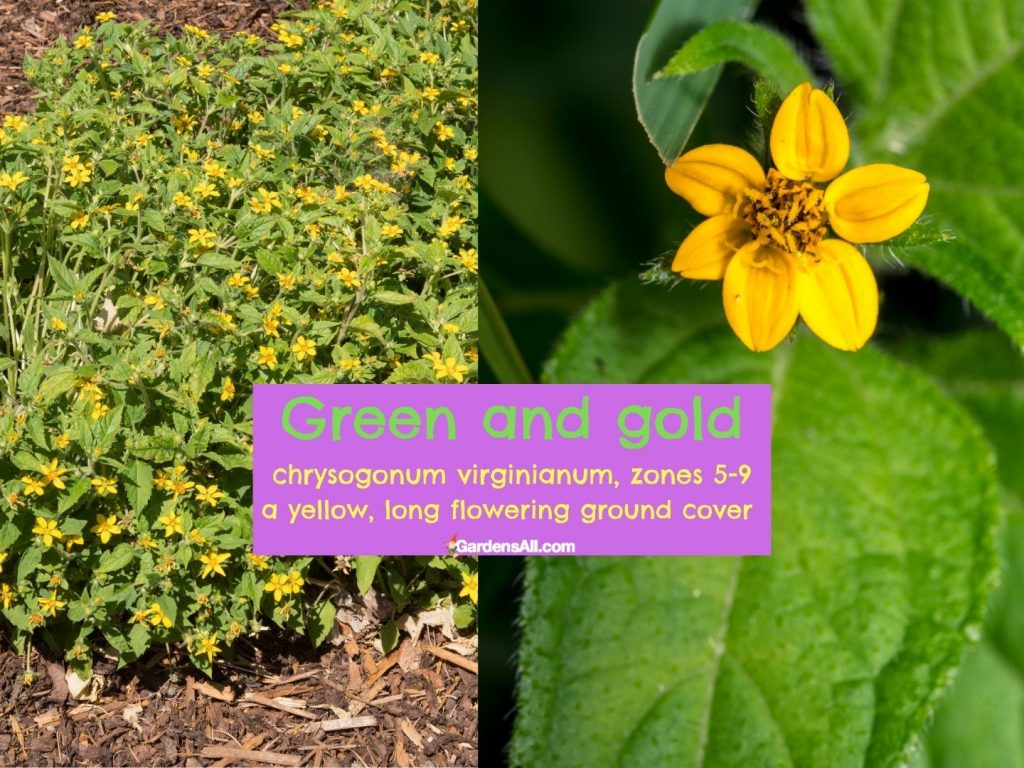
Ground cover with white flowers
And if white flowers are what you’re looking for, there are some ground cover options with white blooms, too.
- Sweet alyssum – (Lobularia-maritima), zones 2-11
- Japanese pachysandra – (pachysandra-terminalis), zones 4-8
- Vancouveria – (vancouveria-hexandra)
Sweet alyssum (Lobularia maritima)- This one is low-maintenance, drought-tolerant, and easy to grow. It usually has white blooms but there are some varieties that can appear blue or purple. It grows 3-9 inches tall and has a wider spread. Flowers typically bloom over time, through the growing season and year-round in mild climates that don’t see a lot of frost. It’s also a good nectar source for native bees.
Japanese pachysandra (pachysandra terminalis) – Here’s another ground cover plant with white flowers you can appreciate. It belongs to the boxwood family and the foliage doesn’t die back in the winter, but it will yellow some. They grow about six inches tall and have a spread of 12 inches or more.
Vancouveria (vancouveria hexandra) – This common herbaceous perennial grows about 1 to 1.5 feet tall and has a spread about the same. It blooms from May to July, and it thrives in part shade to full shade. It’s low maintenance and has medium water requirements.
With so many great choices, how can you be sure to get the best ground cover flowers for your needs and your landscape?
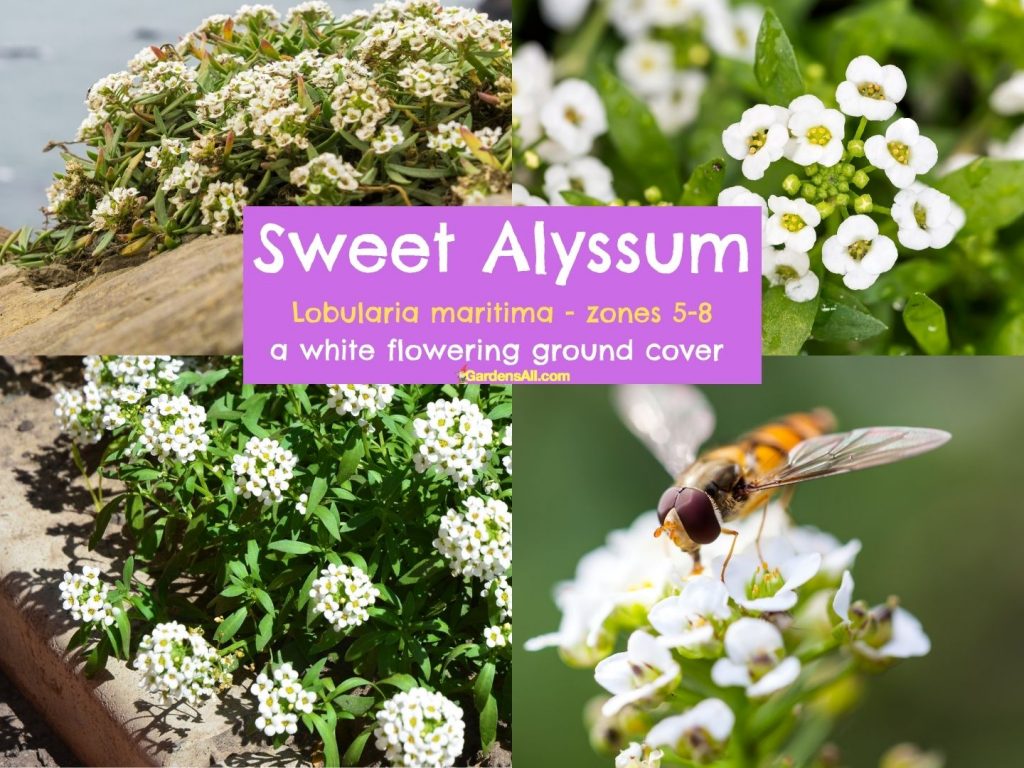
Choosing the Right Ground Cover for Your Landscape
When it comes to ground cover, there are many different options to choose from. Some ground cover plants are low-growing and densely packed, while others have larger leaves and tall stems.
Ultimately, the right ground cover for your needs will depend on several factors, including what types of soil you have, how much sun the area is exposed to, and whether you want it to be ornamental or functional. When looking at potential ground cover plants, consider the following tips:
- CHALLENGES: Try to identify any challenges that your site might present, and select plants accordingly, considering issues such as:
- drought
- erosion
- flooding
- hillside
- rocky
- shade – consider other shade tolerant plants
- sun
- wet – if you have wet prone areas, consider a rain garden
- APPEARANCE: Pay attention to the plant’s appearance and growth habit, including:
- color – complementary to your existing plants and landscape design
- fragrance – place near outdoor living spaces and entrances
- size – consider the size of the plant a few years down the road to be sure it will still work in that location
With the right information and some careful consideration of your needs and preferences, you can find the perfect ground cover for your yard or garden.
Flowering Ground Cover for Shade
When you need ground cover with flowers that can grow in the shade, there are a number of great options. Here are some of the best ground covers for shade that you might consider:
- Bishop’s hat – (epimedium), zone 7
- Bugleweed – (ajuga reptans), zones 3-10
- Bunchberry – (cornus canadensis), zones 2-7
- False goat’s beard – (astilbe biternata), zone 5a-8b
- Ginger / Wild ginger – (asarum), zones 6-9
- Green and gold – (chrysogonum virginianum), zones 5-9
- Japanese pachysandra – (pachysandra terminalis), zones 4-8
- Sweet woodruff – (galium odoratum), zones 4-9
- Vancouveria – (vancouveria hexandra), zones 5-8
- Yellow archangel – (lamium galeobdolon), zones 4-9
What if you need ground cover in a shady spot that grows really fast?
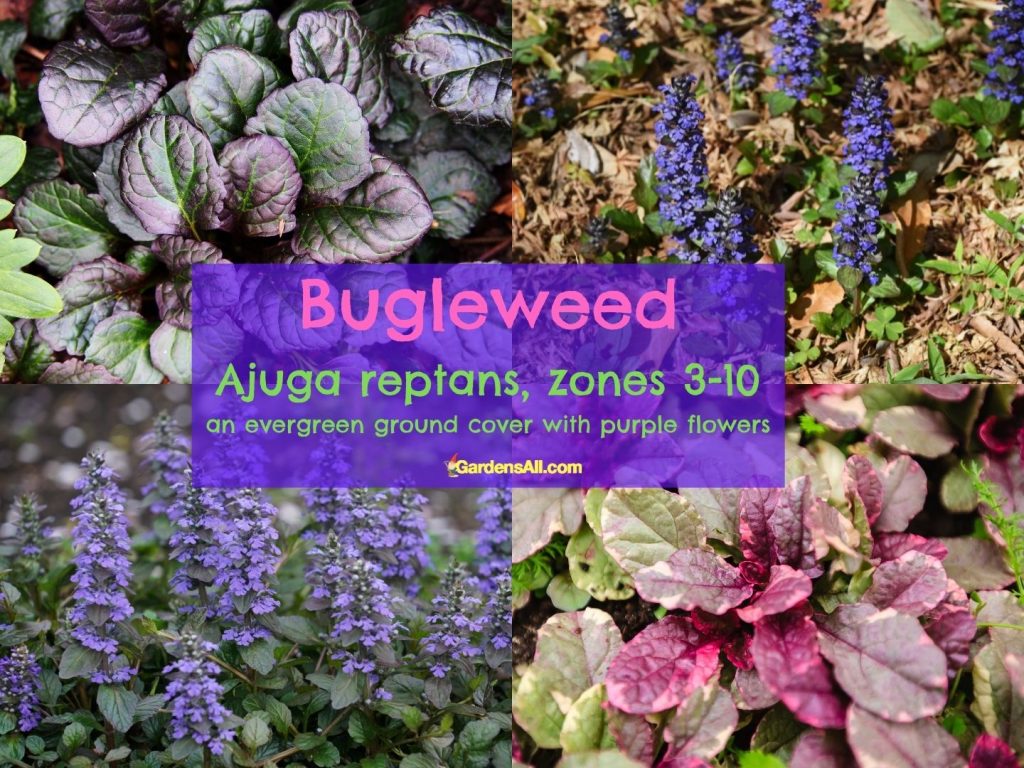
Fast Growing Ground Cover for Shade
What if you’re looking for fast-growing ground covers for shade so that you can establish the landscape without waiting a long time? Some to consider are:
- Coral Creeper, (Antigonon leptopus), zones 9-11
- Sweet woodruff – (galium odoratum), zones 4-9
- Japanese pachysandra – (pachysandra-terminalis)
- Yellow archangel – (lamium galeobdolon), zones 4-9
- Wild ginger – (Asarum canadense), zones 4-8
- Bunchberry – (cornus canadensis), zones 2-7
- Lilyturf – (Liriope), zones 5-10
- Dwarf Solomon’s seal – (Polygonatum humile), zones 3-9
- Goldenstar – (Chrysogonum-virginianum), zones 5-9
- Creeping phlox – (Phlox stolonifera) zones 3-9
Note that not all of the above are blooming. We have included them because they are fast growing and they can complement other blooming ground covers on the list.
Ground Cover That Works Well Under Trees
Now, what if you are looking for ground covers you can plant underneath trees? Here are some considerations:
- Creeping juniper – (Juniperus horizontalis), zones 3-9
- Foamflower – (Tiarella), zones 3-8
- Lungwort – (Pulmonaria), zones 3-8
- Liriope – (Liriope muscari), zones 4-10
- Lesser periwinkle – (Vinca minor), zones 4-9
Using Groundcover Plants Help with Landscape Problems
Here are some common landscaping problems helped by ground cover plants.
- SHADE – Can grow in shade
- TREE ROOTS – Can grow around tree roots
- HILLS – Good for slopes or inclines
- SPACE – Can fill small spaces hard for lawn mowers to reach
- WALKABLE – Feels good underfoot and can take moderate foot traffic
- MOWING-FREE – Can replace grass and mowing
- NATURAL BORDERS – Can be used to create uniform borders for:
- property lines
- sidewalks
- driveways
- defining areas
These are just a few common landscaping challenges that ground cover plants can help remedy. Knowing what problems you’re trying to solve can also help you choose the best plants to get the job done.
When in doubt, you can purchase a landscape survey from an expert to help you determine the best spots for planting ground cover and other plants, based on your lawn’s specific needs and your aesthetic goals.
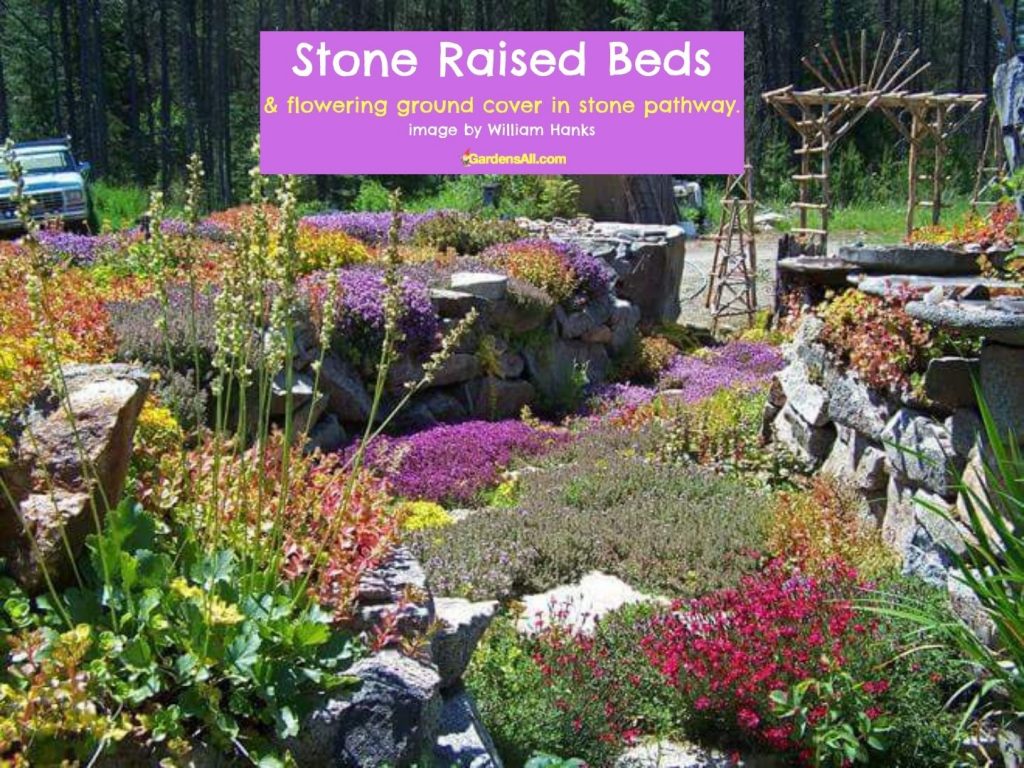
Conclusion
Ground cover with flowers is a great way to add some color and charm to your outdoor space. These kinds of plants offer an attractive cover that helps to prevent erosion, nourish the soil, and retain moisture while also serving as a decorative addition to any garden or patio area.
Not only are ground covers with flowers easy to take care of and low maintenance, but they come in a wide range of vibrant colors and flower types, so you can easily find one that suits your taste and preferences.
Whether you simply want to provide some aesthetically pleasing ground cover for your yard or flowerbed, or if you’re looking for something more vibrant for an outdoor wedding or social event, ground cover with flowers can add that extra touch of elegance.
Low Maintenance Ground Cover Plants
10 Best Low Maintenance Ground Cover With Flowers
Here is the list of plants in this video.
- Bunchberry – (cornus canadensis), zones 2-7
- Catnip or catmint – (Nepeta cataria or Nepeta faassenii), zones 3-9
- Creeping juniper – (Juniperus horizontalis), zones 3-9
- Creeping phlox – (Phlox stolonifera) zones 3-9
- Creeping thyme – (thymus serpyllum), zones 4-9
- Mountain Cornflower, AKA Amethyst in Snow – (Centaurea montana), zones 3-8
- Rock Cotoneaster – (Cotoneaster horizontalis ‘Perpusillus’), zones 4-7
- Sedums – (Sedum or Orpine), zones 3-11
- Wall germander – (Teucrium chamaedrys), zones 5-9
- Yellow alyssum – (Aurinia saxatilis), zones 3-7
We are an online gardening publication sharing all things garden related! Including urban farming, family gardening, homesteading, gardening for profits, and more. We’re all about growth!

